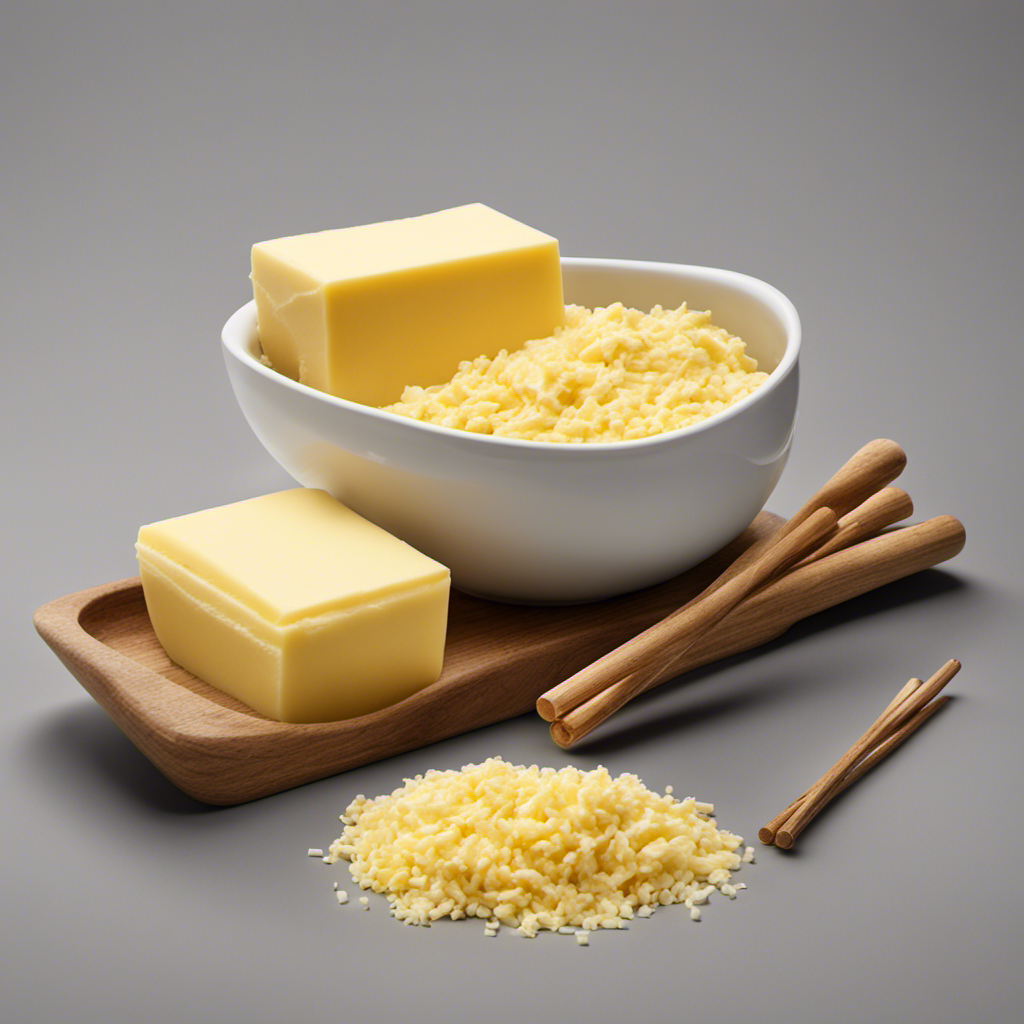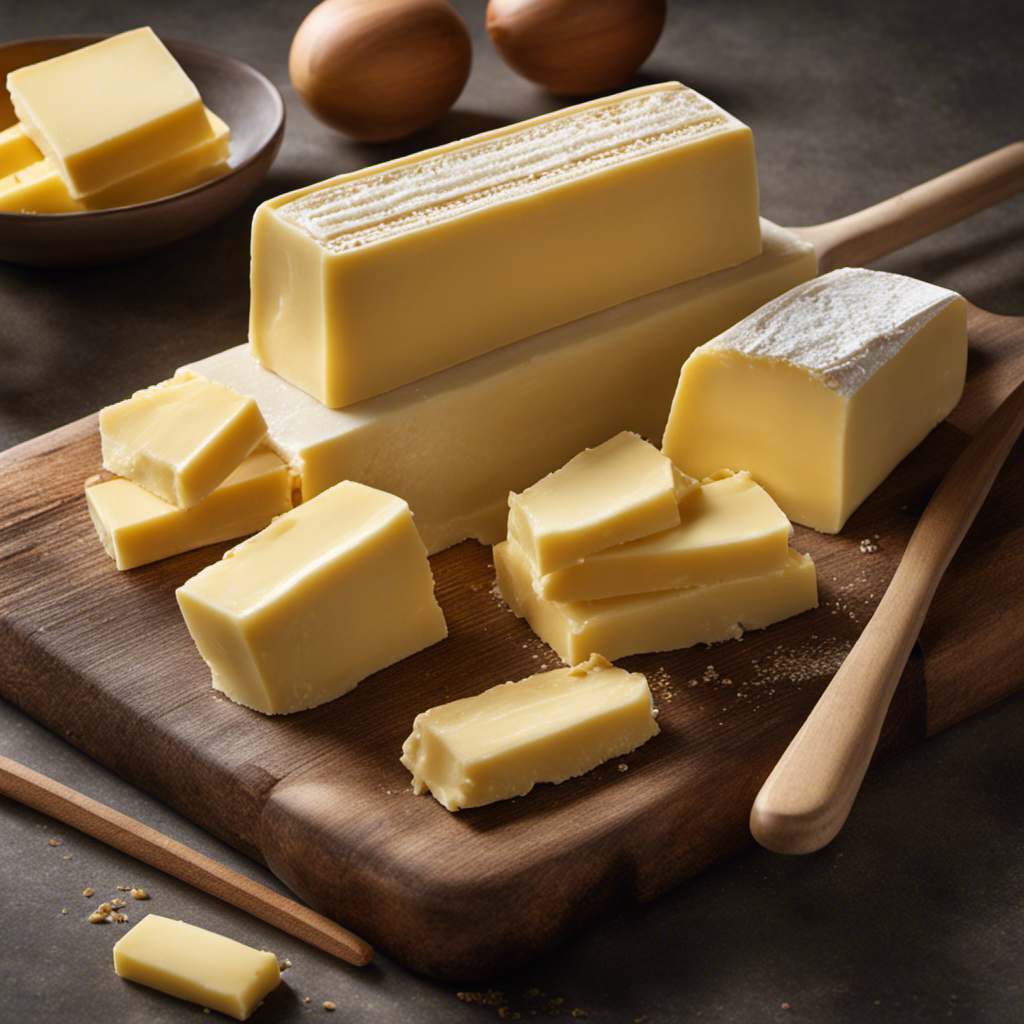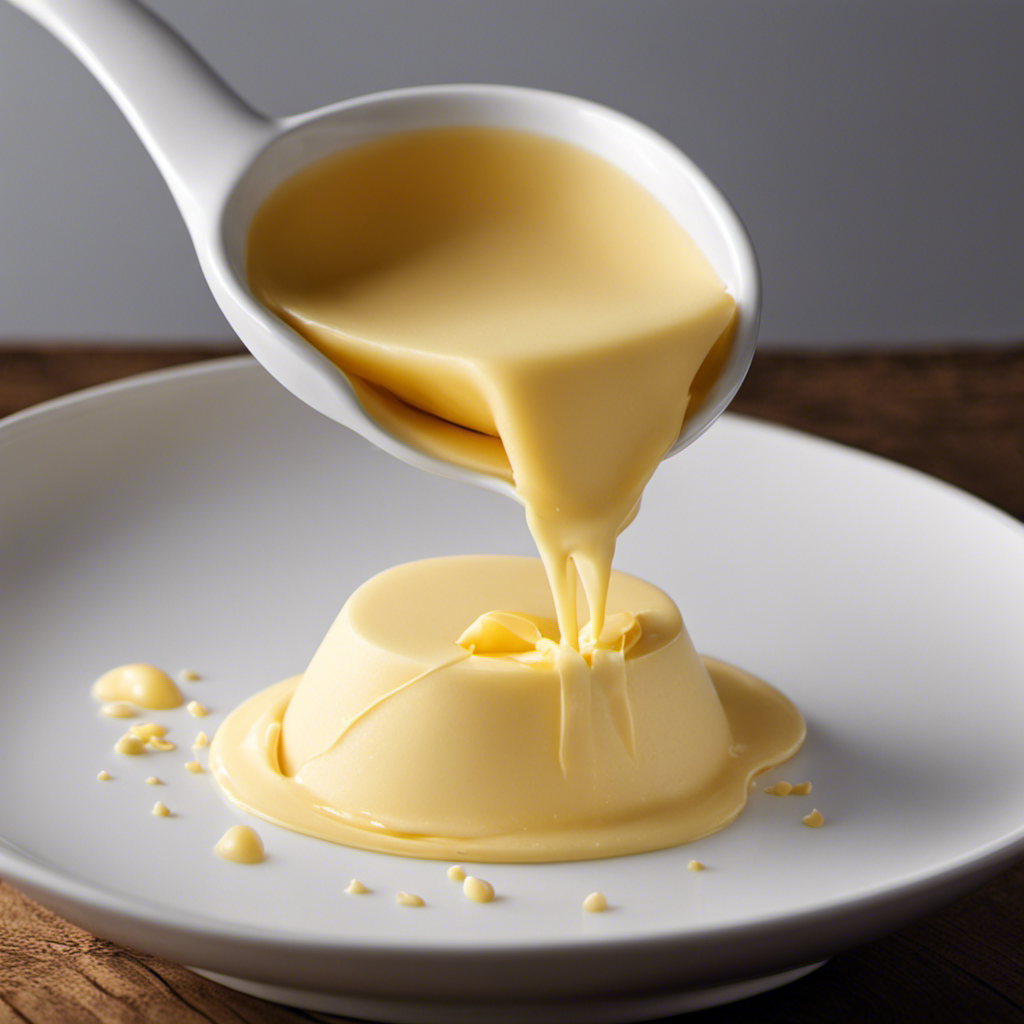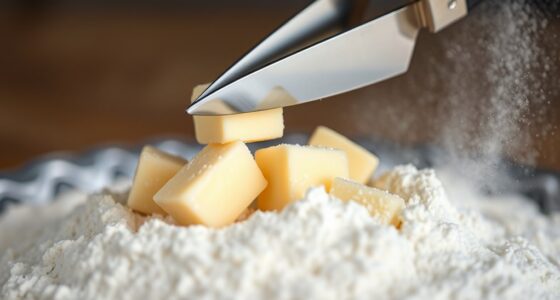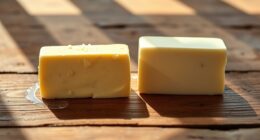I’ve always thought that grasping the concept of butter measurements can feel somewhat akin to making your way through a labyrinth. However, worry not, for I am here to illuminate this subject for you.
Have you ever wondered how many sticks of butter are in 3/4 cup? Well, you’re in luck! In this article, we’ll break down the relationship between sticks and cups, explore the standard size of a stick of butter, and calculate just how many sticks you’ll need for that 3/4 cup.
Get ready to become a butter-measuring pro!
Key Takeaways
- 3/4 cup of butter can be converted to 1.5 sticks of butter
- Converting cups to sticks eliminates guesswork in recipes
- Precision in butter measurements is crucial for the success of the dish
- Understanding the relationship between sticks and cups ensures accurate measurements
Understanding Butter Measurements
Butter measurements can be confusing, especially when trying to determine how many sticks are in 3/4 cup. Converting butter measurements requires precision to ensure accurate results in your recipes.
When it comes to butter, the standard measurement is a stick, which typically weighs around 1/2 cup or 8 tablespoons. To convert 3/4 cup of butter into sticks, you need to know that 1 stick equals 1/2 cup. Therefore, 3/4 cup of butter is equal to 1 and a half sticks.
It’s important to remember that precision in butter measurements can greatly affect the outcome of your recipe. So, it’s always a good idea to double-check your conversions to ensure that you’re adding the right amount of butter to your dishes.
Converting Butter Measurements
When it comes to baking, precise measurements are crucial for achieving the perfect results. In this discussion, we will explore the world of butter measurements.
Starting with understanding butter measurement equivalents, we will also dive into the process of converting cups to sticks of butter. It is important to note the importance of precision in butter measurements.
Butter Measurement Equivalents
To measure 3/4 cup of butter, you’ll need to use 1 and 1/2 sticks. Butter is commonly measured in sticks, cups, and grams, depending on the recipe or preference. Converting butter to grams can be helpful when following international recipes or using a kitchen scale for precise measurements. Here are some different units for measuring butter:
- Sticks: 1 stick of butter is equal to 1/2 cup or 113 grams.
- Cups: 1 cup of butter is equal to 2 sticks or 226 grams.
- Grams: 1 gram of butter is equal to 0.0044 cups or 0.0088 sticks.
- Ounces: 1 ounce of butter is equal to 2 tablespoons or 28.35 grams.
Knowing these equivalents can make it easier to adapt recipes and ensure accurate measurements.
Now, let’s move on to converting cups to sticks for a better understanding of butter measurements.
Converting Cups to Sticks
Converting cups to sticks can be helpful for accurately measuring butter in recipes. Understanding conversions is essential for achieving measuring precision in cooking.
When a recipe calls for a specific amount of butter in cups, it can be converted to sticks to ensure accuracy. One stick of butter is equal to 1/2 cup or 8 tablespoons. So, if the recipe requires 3/4 cup of butter, it can be converted to 1.5 sticks of butter.
Converting cups to sticks helps eliminate any guesswork and guarantees that the recipe will turn out as intended. Precision in butter measurements is crucial because butter plays a significant role in the texture, flavor, and overall success of the dish.
Precision in Butter Measurements
You can achieve precision in butter measurements by understanding the importance of accurate measuring in cooking. When it comes to baking or cooking, precise measurements are crucial for achieving consistent and delicious results.
Here are four key points to keep in mind:
-
Accurate measurements ensure that you use the right amount of butter in your recipe, which can greatly affect the texture and flavor of your dish.
-
Precision in measurements also helps you maintain the correct balance of ingredients, ensuring that your dish turns out as intended.
-
Using the correct amount of butter can impact the overall moisture content of your baked goods, resulting in a perfect crumb and texture.
-
Proper measuring techniques, such as leveling off the butter with a knife or using a kitchen scale, can help you achieve the desired amount of butter and avoid any discrepancies.
The Relationship Between Sticks and Cups
The relationship between sticks and cups can be easily understood by knowing that 1 stick of butter is equal to 1/2 cup. This understanding is crucial when it comes to converting butter ratios and understanding butter packaging.
Many recipes call for specific amounts of butter in cups, while butter packaging often displays the quantity in sticks. Knowing the conversion between the two is essential for accurate measurements in baking and cooking.
For example, if a recipe requires 3/4 cup of butter, it can be easily calculated that it is equivalent to 1 and a half sticks of butter. This knowledge allows for seamless transitions between different measurements, ensuring that your culinary creations turn out just right.
The Standard Size of a Stick of Butter
To understand the standard size of a stick of butter, it’s important to know that it typically measures 1/2 cup. This measurement is widely used in recipes and makes it easier to portion out the butter when cooking or baking.
Here are some key points to keep in mind when it comes to understanding butter substitutes and measuring accurately:
-
Butter substitutes: If you’re looking for a healthier alternative to butter, there are several options available such as margarine, coconut oil, or olive oil. However, keep in mind that these substitutes may have a different texture and taste compared to butter.
-
Measuring accurately: To measure butter accurately, it’s best to use a kitchen scale. If you don’t have one, you can use the measurement markings on the butter packaging. Each stick of butter is typically marked with tablespoons and ounces, making it easy to measure the desired amount.
-
Softening butter: Many recipes call for softened butter. To soften butter quickly, you can cut it into small pieces and let it sit at room temperature for about 15-20 minutes. Alternatively, you can use a microwave on low power for short bursts, checking frequently to avoid melting the butter.
-
Room temperature butter: Some recipes may specify using room temperature butter. This is because room temperature butter blends more easily with other ingredients and helps create a smoother texture in baked goods. To bring butter to room temperature quickly, you can cut it into small pieces and let it sit for about 30 minutes to an hour.
Understanding butter substitutes and measuring accurately are essential skills in the kitchen. By following these tips, you can ensure that your recipes turn out delicious every time.
Calculating the Number of Sticks in 3/4 Cup
If you want to calculate the number of sticks in 3/4 cup of butter, you can easily do so by dividing the cup measurement by the standard size of a stick.
The standard size of a stick of butter is typically 1/2 cup or 8 tablespoons.
Therefore, to determine the number of sticks in 3/4 cup, you would divide 3/4 by 1/2. This gives you a result of 1.5 sticks.
So, 3/4 cup of butter is equivalent to 1.5 sticks of butter.
It’s important to note that this calculation assumes the accuracy of the cup measurement and the standard size of a stick.
If you are looking for butter alternatives, there are various options such as margarine, ghee, or coconut oil that can be used as substitutes in recipes.
Using Measuring Cups for Butter
When measuring butter, make sure to use the correct measuring cups for accurate results. Using the right tools is crucial in the kitchen, especially when it comes to baking. Here are four important things to consider when measuring butter:
-
Use measuring cups specifically designed for butter. These cups usually have markings that indicate different measurements, making it easier to get precise amounts.
-
Pay attention to the conversion methods. Butter is often sold in sticks, and each stick typically equals 1/2 cup. So, if a recipe calls for 1 cup of butter, you would need two sticks.
-
Be mindful of butter packaging. Some brands package butter in different shapes or sizes, such as rectangular blocks or tubs. Always check the packaging for measurement information to ensure you’re using the correct amount.
-
Remember to measure butter when it’s at room temperature. This allows for easier scooping and more accurate results.
By following these tips, you can ensure that your measurements are spot-on and achieve the desired outcome in your recipes.
Now, let’s explore alternative measurements for butter.
Alternative Measurements for Butter
When it comes to butter substitutes, there are a few options to consider. Whether you’re looking to reduce the fat content or accommodate dietary restrictions, there are various alternatives available, such as margarine or vegetable oils.
However, it’s important to note that these substitutes may affect the taste and texture of your baked goods.
Butter Substitutes
There’s a variety of butter substitutes available for those who prefer not to use regular butter. These alternatives not only cater to those who follow a vegan lifestyle but also offer numerous health benefits. Here are four options to consider:
-
Coconut oil: It provides a rich and creamy texture similar to butter, making it a popular choice for baking and cooking. It is also high in medium-chain triglycerides, which are known to boost energy and support weight loss.
-
Avocado: This fruit is packed with healthy fats and offers a smooth, buttery texture. It is a great choice for spreading on toast or using in recipes that call for butter.
-
Nut butters: Almond, cashew, and peanut butter can be used as a substitute for butter in many recipes. They add a nutty flavor and provide a good source of protein and healthy fats.
-
Applesauce: This versatile ingredient can be used as a substitute for butter in baking. It adds moisture and sweetness to recipes while reducing the fat content.
Measuring Butter Accurately
To accurately measure butter, it’s important to use a kitchen scale rather than relying on measuring cups. Precision in measuring is crucial when it comes to baking and cooking, especially when it comes to butter.
Measuring cups can be inconsistent, leading to inaccurate results in your recipes. A kitchen scale provides a more precise and consistent measurement, ensuring that you use the exact amount of butter needed.
Here are some tips for accurate butter measurement:
- Place your empty container on the scale and zero it out.
- Cut the butter into the required measurement, using a knife or butter slicer.
- Add the cut butter to the container on the scale until you reach the desired weight.
- Remove any excess butter, if necessary, to achieve the precise measurement.
Tips for Accurate Butter Measurement
For accurate butter measurement, it’s helpful to soften the butter slightly before measuring. Softening the butter makes it easier to work with and ensures more precise measurements. Here are some tips to help you measure butter accurately:
-
Use a kitchen scale: Weighing the butter on a scale provides the most precise measurement. This is especially important for baking recipes that require precise ratios.
-
Use measuring cups: If you don’t have a scale, using measuring cups is the next best option. Fill the cup with softened butter, making sure there are no air gaps or spaces.
-
Mark the butter wrapper: To easily measure butter, you can use the markings on the butter wrapper. Each tablespoon is usually marked, making it convenient to measure smaller amounts.
-
Alternative butter substitutes: If you’re looking for a healthier or dairy-free option, you can use alternative butter substitutes like margarine or vegetable shortening. Just make sure to check the conversion ratios for your specific recipe.
By following these tips, you can ensure accurate butter measurement precision and successfully incorporate alternative butter substitutes into your recipes.
Now, let’s move on to the next section where we will discuss adjusting recipes for different butter measurements.
Adjusting Recipes for Different Butter Measurements
If you need to adjust a recipe for different butter measurements, you can try using alternative butter substitutes or measuring the butter by weight.
Butter measurement equivalents can be confusing, especially when recipes call for different units like cups, tablespoons, or sticks. To make things easier, you can substitute butter with alternatives like margarine or vegetable shortening. These substitutes have similar consistencies and can be used in equal amounts as butter.
Another option is to measure butter by weight using a kitchen scale. This eliminates any guesswork and ensures accuracy in your recipes.
Converting stick measurements for different butter brands can be tricky, but with a little research, you can find conversion charts online or use the markings on the packaging to determine the equivalent measurements.
Converting Stick Measurements for Different Butter Brands
When converting stick measurements for different butter brands, you may find it helpful to refer to conversion charts or the markings on the packaging. Converting butter measurements can be a bit tricky, especially when you’re using a recipe that calls for a specific amount of butter in sticks, but the brand you have on hand doesn’t provide stick measurements.
Here are a few tips to help you achieve butter measurement precision:
-
Check the packaging: Some butter brands have markings on the packaging that indicate how much each stick weighs. This can be useful when you need to convert stick measurements to cups or grams.
-
Use a conversion chart: Many cooking websites and cookbooks offer conversion charts that show you how many cups or grams are in a stick of butter. Keep a bookmark or printout of these charts for easy reference.
-
Experiment and adjust: If you’re unsure about the precise measurements, it’s always a good idea to experiment a bit. Start with a smaller amount of butter and adjust as needed. Remember, cooking is all about trial and error!
-
Be mindful of the recipe: Keep in mind that different recipes may call for different levels of precision when it comes to butter measurements. For some recipes, a slight variation in the amount of butter may not make a big difference, while for others, it could affect the texture and taste.
Common Mistakes When Measuring Butter
When it comes to baking, there are a few common mistakes that can easily be made when measuring butter.
Firstly, using incorrect measuring techniques can throw off the entire recipe.
Secondly, using the wrong utensils, such as a liquid measuring cup instead of a dry measuring cup, can lead to inaccurate measurements.
Lastly, ignoring the butter’s temperature can greatly affect the texture and consistency of the final product.
Incorrect Measuring Techniques
Using incorrect measuring techniques can lead to inaccurate measurements when baking. It is important to measure ingredients properly to ensure the desired outcome of your baked goods. When it comes to measuring butter alternatives, such as margarine or coconut oil, it’s essential to follow these measurement hacks:
-
Soften the butter alternative: If the recipe calls for softened butter, make sure to soften the alternative in the same way. This will ensure accurate measurements and proper texture in your baked goods.
-
Use a measuring cup: Instead of eyeballing the amount, use a measuring cup specifically designed for measuring butter alternatives. This will give you precise measurements and avoid any guesswork.
-
Level off the measurement: When measuring butter alternatives, make sure to level off the top with a straight edge, such as a spatula or knife. This will ensure that you’re using the exact amount required in the recipe.
-
Follow the recipe instructions: Different butter alternatives may have different densities, so it’s important to follow the recipe instructions carefully. This will ensure that the measurements are accurate and the texture of your baked goods turns out just right.
Using the wrong utensils, on the other hand, can also affect the accuracy of your measurements. Let’s explore this further…
Using the Wrong Utensils
To ensure accurate measurements, it’s important to avoid using the wrong utensils when measuring butter alternatives.
When it comes to butter measurement accuracy, using the right tools is essential. One common mistake people make is using a regular table knife instead of a measuring spoon or cup. While a table knife may seem convenient, its shape and size can lead to inaccurate measurements.
Another common error is using a liquid measuring cup instead of a dry measuring cup. Liquid measuring cups are designed to measure fluids, not solid ingredients like butter. This can affect the accuracy of the measurement and throw off your recipe.
To get precise measurements, invest in a set of measuring spoons and cups specifically designed for dry ingredients.
Ignoring Butter Temperature
When it comes to baking, one mistake I often make is ignoring the temperature of the butter. Many recipes call for softened or room temperature butter, but I often forget to take it out of the fridge ahead of time. This can cause problems when trying to cream the butter with sugar or incorporate it into the batter.
To avoid this issue, I’ve learned a few tricks. Firstly, I can soften butter quickly by placing it in the microwave for a few seconds. Secondly, I can use alternative measurements for butter, such as using oil or margarine instead. Thirdly, I can convert butter measurements to make it easier to work with. And finally, I can plan ahead and leave the butter out on the counter to reach room temperature naturally.
Frequently Asked Questions
Can I Use Margarine Instead of Butter in This Recipe?
Sure, you can use margarine instead of butter in this recipe. However, keep in mind that margarine may have a different taste than butter. Butter also has health benefits, such as being a good source of vitamins A, D, and E.
How Do I Measure Butter if I Don’t Have Measuring Cups?
When I don’t have measuring cups, I find alternative ways to measure butter. I use the markings on the butter wrapper or a kitchen scale to measure the desired amount accurately.
Can I Use a Kitchen Scale to Measure Butter Instead of Using Sticks or Cups?
Using a kitchen scale to measure butter has pros and cons. It’s accurate but may require conversion. Alternatives to measuring cups include using tablespoons or eyeballing. Experiment and find what works best for you!
Are There Any Substitutes for Butter if I Don’t Have Any on Hand?
If you don’t have butter on hand, there are several substitutes you can use in baking. Oil, applesauce, and yogurt can all be used to replace butter. Experiment and find what works best for your recipe.
What Is the Best Way to Store Butter to Ensure Its Freshness and Quality?
To keep butter fresh and prevent spoilage, the best practice is to store it in an airtight container in the refrigerator. This helps maintain its quality and ensures it stays fresh for a longer period of time.
Conclusion
In conclusion, understanding butter measurements is key to achieving culinary success. Converting between sticks and cups allows for precise measurements in recipes. The standard size of a stick of butter is a helpful reference point. By calculating that 3/4 cup of butter equals 1.5 sticks, we can ensure accurate proportions in our cooking endeavors.
Remember, precision is vital when measuring butter, so be mindful of common mistakes. With this knowledge, we can confidently create delectable dishes that will leave a lasting impression on our taste buds.
